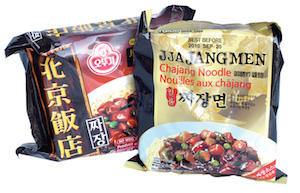Treat yourself to Koreanized Chinese food, a hybrid cuisine that keeps crossing borders.
By Kai Ma and Lola Pak
Due to geographical proximity, migration, and a convoluted history that includes both kinship and war, the Koreans and Chinese have long engaged in the cultural exchange of ideas — and recipes. The delectable result: Korean Chinese food, a fusion cuisine of traditionally Chinese fare influenced by Korean ingredients, and vice versa.
A Korean Chinese restaurant may offer kimchi as an appetizer and fortune cookies for dessert, but the key dishes of this edible genre are influenced by both countries. Jjambbong, for example, blends a Chinese seafood noodle soup with a red-orange broth more typically found in Korean stews. Tangsuyuk, a Koreanized variant of Chinese sweet-and-sour pork distinguished by a brown (versus red) sauce, is a sugar-laced treat consumed with hot pepper flakes and fluorescent yellow slices of dahn-mu-ji (radish). But the most popular dish is jjajangmyeon, a bowl of noodles doused in black bean paste and saturated with minced onions.
[ad#300]
Distinguished by Mandarin storefronts, Korean Chinese eateries are found in most American Koreatowns and staffed by first-generation Koreans. Though some, such as Little Dragon in Gardena, Calif., are run by Chinese chefs who previously lived in South Korea.
Mei Chou, a waitress at Little Dragon, is a Chinese expatriate who grew up in Daegu, South Korea. “Korean Chinese food is a lot of heavy noodles with some fried meats,” she says. “My favorite Korean Chinese dish is kkanpoong saewoo (sautéed shrimp with garlic sauce).”
Korean Chinese recipes may differ slightly, depending on the Chinese region a chef is inspired by. Restaurants influenced by northern China will serve larger portions of noodles and dumplings, whereas the southern style places more emphasis on seafood. And, adds Chou, “in the United States, some of the sauces are redder because Americans like ketchup.”
This dual-powered grub was cooked up by the ethnic Chinese in Korea, particularly in Incheon, a port city known for its still-standing Chinatown. Over the years, recipes have been tweaked to suit the Korean palate, but the dishes often lack the harsh spices and garlic that dominate most Korean meals. Still, a post-meal breath mint is recommended: panchan includes a small plate of crunchy raw white onions dipped in fermented black bean sauce.
Here’s a breakdown of our favorite delicacies:
Jjambbong
This seafood noodle soup comes in a spicy red-orange broth — which clearly indicates its Koreanness. Created in Incheon among hwagyo (ethnic Chinese raised in Korea) residents, jjambbong is viewed as more Korean-slanted fare.
Mandu
Pot stickers can be ordered steamed or boiled, but the pan-fried meat alternative is favored among dumpling fanatics. These humongous appetizers are usually stuffed with ground pork, napa (Chinese cabbage), ginger and soy sauce, whereas Korean mandu can include kimchi or tofu.
Jjin bbang
Steamed sweet bread, a revered snack in both China and Korea, is often served in Korean Chinese restaurants to help soak up its sauce- and grease-heavy counterparts. Called baozi in Chinese and jjin bbang in Korean, these doughboys can be served fluffy or chewy, and are often stuffed with pork, onions or red bean paste.
Jjajangmyeon
The poster child of Chinese and Korean fusion cuisine, jjajangmyun is a black-sauced staple. A different take on the northern Chinese dish za jiang mien, which relies on yellow bean paste, the Koreannized version uses thick noodles and a black bean sauce mixed with zucchini, onions, pork, and sometimes shrimp.
Mix thoroughly with wooden chopsticks before consumption.
Tangsuyuk
Coated in a gooey sauce of sugar, vinegar and cornstarch, tangsuyuk is a heap of battered deep-fried sweet-and-sour meat. Part crunchy, part squishy, the pork, chicken or beef comes with a veggie medley of carrots, napa leaves, cucumbers, mushrooms, pineapples, and onions. Dip the pieces in a mixture of soy sauce and crushed pepper flakes for a spicy pep.
Kkanpoongki
There’s no red sauce or other form of spiciness apparent, but this deep-fried chicken dish should be eaten with caution. The kick comes from the sauce — a mix of cornstarch and oil that’s infused with roasted peppers.
[ad#300]







